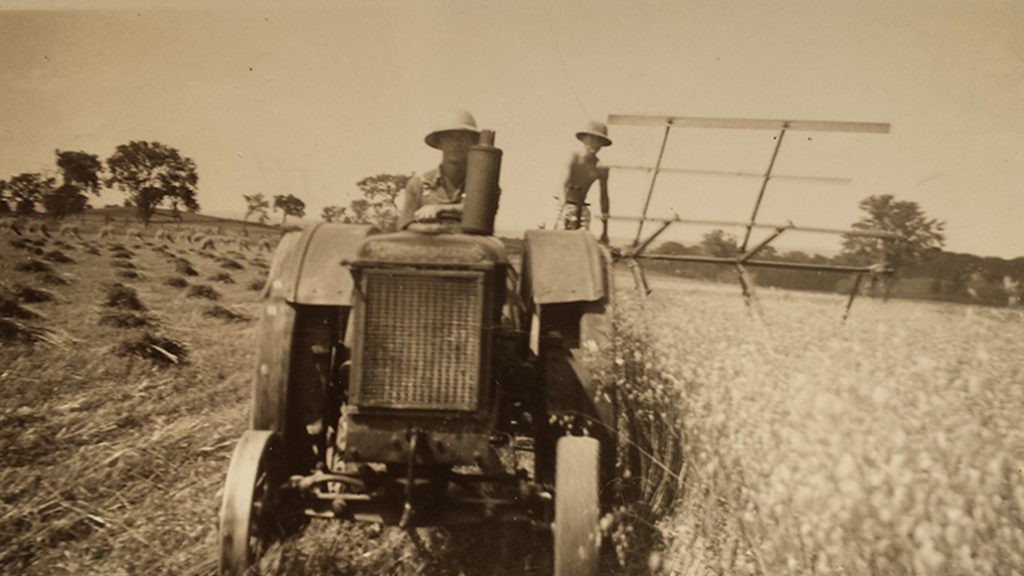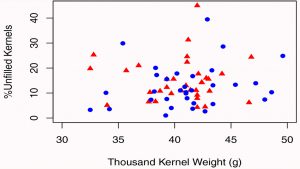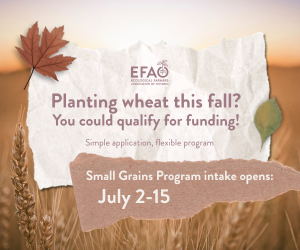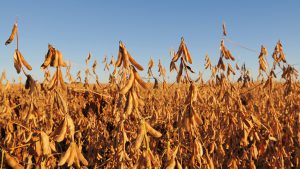Advances in oat breeding
YIELD RESEARCH

HERE IS A little quiz. The picture below shows an oat harvest in Quebec in 1949. Now, what has changed since that time, and what has stayed the same?
Obvious changes include the machinery and farm fashion. This crop was essentially organic, although it wasn’t designated as such at the time. It was grown from certified seed, but the yield potential of current varieties is much higher. At the time, farmers in the region considered 40 bushels/acre to be a good crop.
What hasn’t changed is the basic method used to select oat varieties. The tools have changed — there are now GPS-guided seeders, sophisticated plot combines, NIRS (near infrared reflectance spectroscopy) for quality determination, and molecular markers for some diseases — but the basic principle is still the same. Breeders create new genetic combinations by crossing two parents, eliminate some lines by visual selection, and then test stable lines in plot trials for yield potential.
This system has given significant and steady yield improvements, but it is not without its problems. It is expensive, since even a modest program can spend over $150,000 annually on plot testing, and is not particularly efficient, because only a small portion of the progeny from a cross are actually tested.
PhytoGene Resources decided to investigate a different approach, using selection for yield components in individual panicles (the oat head). Rows from single panicles in the segregating generations are evaluated for agronomic performance, and primary panicles from the top 25 per cent are harvested. Each panicle is then evaluated for yield-related parameters, and the process is repeated.

FIRST STEPS
The first step was to get a better understanding of grain fill dynamics in individual panicles, and then determine the interactions among those parameters. Several hundred primary panicles were taken from the breeding nursery and (laboriously) deconstructed. Each individual kernel was weighed, and its position in the panicle recorded (panicle node, branch number, position on the branch, and primary vs secondary kernel).
The initial analysis gave many insights and some surprises. First, the most important factor affecting yield is the number of kernels set. This was not a big surprise, but the very close association with yield was not expected. More surprising though, was the fact that the number of kernels in a panicle was not related to kernel size. There was no compensation or trade-off between the two parameters. Since both traits are highly heritable, but independent, it was possible to identify families with high kernel set and high thousand kernel weight (TKW).
…AND SURPRISES
The panicle analysis also revealed a major surprise: many of the ‘thin’ kernels in oat are actually ‘unfilled’ — with no groat at all, or even vestiges of floral parts. Therefore, they were not the result of stress during grain fill. Unfilled kernels were found throughout the panicle, seemingly at random. There were large differences among families for the per cent unfilled, and the trait seemed to be quite heritable. Most important though, it was the second most important parameter linked to yield.
Unfilled kernels quickly became the focus of further investigation. There was no detectible effect on associated primary or secondary kernels, so the carbohydrate that would have been available to fill these kernels was apparently not redistributed. Therefore, unfilled kernels are a lost opportunity for grain development, and a direct reduction in yield potential.
A 2016 study supported by Grain Farmers of Ontario evaluated 100 lines at three diverse Ontario sites. Results confirmed the importance of this trait, which is determined by both genetic (stress tolerance) and environmental effects.
MOLECULAR MARKERS
A separate study supported by Grain Farmers of Ontario was initiated in 2017 to determine if known variations in genetic sequences could be linked to yield component traits, particularly percent unfilled kernels. Such associations, if present, would form the basis of molecular markers for yield parameters. No such markers currently exist in oats.
A total of 68 elite lines from the University of Saskatchewan (Crop Development Centre) are being ‘genotyped’ — evaluated for variation at 3,000 sites on the chromosomes. They were divided into two groups and were grown in three-repetition trials at the Cumberland nursery. Fifteen primary panicles were harvested from each plot for yield component analysis. Results for TKW and percent unfilled kernels are shown in the graph.
The two traits are clearly independent, and there was wide variation among lines for both. It is interesting that some lines had close to 50 per cent unfilled kernels: that is almost half the yield potential!
Wide variation among lines and highly precise measurements are essential for marker development. The data generated met both criteria, and the molecular analysis will be completed once the genomic data are available.
MOVING ON
Kernel set, TKW, and per cent unfilled kernels are basic, easily measured yield components. The first set of 600 lines selected through this protocol was tested in field plots in 2016. The results make clear that effective selection for improved yield potential could be made through panicle analysis.
Other aspects of grain fill are being investigated. Uniformity of kernel size is of particular importance to the milling industry. Measuring this parameter is challenging, particularly since kernel thickness cannot be measured using digital image analysis — the obvious choice for evaluation of size distribution.
Kernels in the lower portion of the panicle — which are the last to develop — often do not fill completely as those at the top. This is probably related to stress late in the filling period, but finding an easily measured parameter is a challenge.
Kernel shape has emerged as an important factor affecting test weight — an important quality criterion. Some families with very high kernel set and good TKW tended to have long, slender kernels. They showed excellent yield potential in plot trials, but test weights were low.
There is obviously still a great deal to be learned about kernel fill in oat, and the genetic control of the many factors involved. The evaluation of individual panicles has been an excellent approach for understanding the dynamics and as a breeding tool. There is every reason to believe that substantial progress can be achieved in improving oat yield, yield stability, and quality.
A.R. McElroy is research coordinator at PhytoGene Resources Inc. M.S. McElroy is a PhytoGene research associate (part time) and winter wheat breeder at the ‘Centre de recherches sur les grains inc.’ (CÉROM), in Québec. •






















